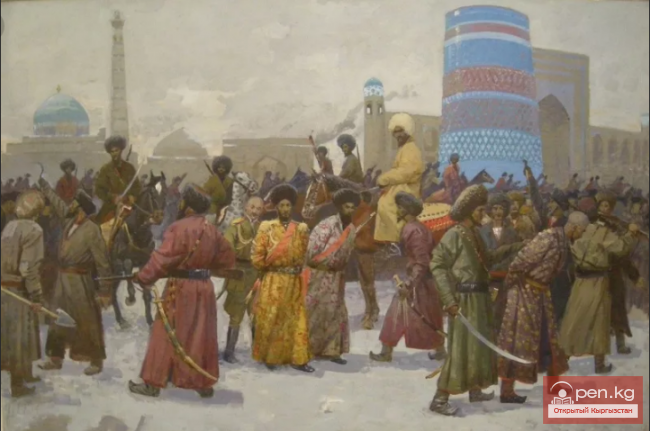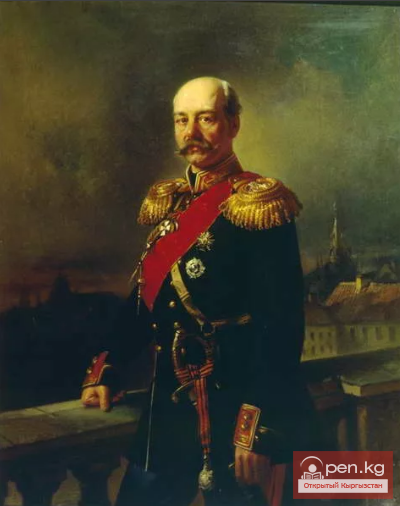Peasant Movement
As the factual materials presented above show, the uprising of 1873-1876 was a joint performance of the working Uzbeks, Kyrgyz, Tajiks, and Karakalpaks, who suffered under the oppression of the Kokand feudal lords led by the khan. The commonality of their historical fate, the increasingly oppressive feudal burden, and the support of the tsarist authority united and raised the workers of these fraternal peoples to fight for popular freedom.
National enmity and distrust among the peoples, which were vigorously propagated by the Kokand khans and their officials, as well as local feudal lords, could not prevent the workers from uniting in a common struggle against the oppressors. The joint performance of Uzbeks, Kyrgyz, Tajiks, and Karakalpaks in the uprising of 1873-1876 is reflected in official archival documents. Weinberg, a witness to the attack of the rebels on the Kokand khan and the surrounding feudal lords, noted in the summer of 1874 that "the settled population (Uzbek and Tajik peasants—K.U.) along with the nomads (Kyrgyz and Kipchak common herders—K.U.) were burdened by the current state of affairs in the khanate, and if there was no solidarity between these two elements, it was not because they were hostile to each other: such relations exist between the main representatives (feudal lords—K.U.) of these nationalities, the commoner or peasant or worker fully sympathizes with the nomad living with his herds." Kaufman, who closely monitored the course of the uprising, noted that "in the winter of 1874-1875, discontent with the khan was growing and finally by the spring of 1875 it engulfed the entire population of the khanate, not only the nomadic (Kyrgyz and Kipchak—K.U.) but also the settled Uzbek and Tajik." The commander of the punitive detachment, Major General Skobeleva, emphasized in early January 1876 that the Uzbeks, Kyrgyz, Kipchaks, and Tajiks, gathering in the city of Andijan, numbering up to 80,000 people, "by common consent swore to defend themselves to the last strength and not retreat, regardless of any losses." The social interests of the working Uzbeks, Kyrgyz, and Tajiks united them in the struggle against feudal-khan oppression and its defender—the tsarist authority.
In its social essence, this uprising represented a peasant movement. At its core was the struggle for land. However, different classes viewed land differently. For the Uzbek, Kyrgyz, and Tajik working peasants, land was a necessary condition for existence, while Abdurakhman Aftobachi, Isa Auliye, and other large feudal lords regarded land as property inherited from their predecessors. This struggle was born and exacerbated by the narrowing of land holdings due to the displacement of working peasants from their settled plots, the usurpation of pastures by the nomadic nobility, and the occupation of a large part of the territory of the Kokand khanate by tsarist troops.
Like other peasant uprisings, the uprisings of 1873-1876 were spontaneous, local, fragmented, and unorganized, born from patriarchal life, economic, political, and cultural backwardness of the rebels. There was not always and not everywhere a unified leadership of the uprising, although the common leaders were considered Pulat-khan and Abdurakhman Aftobachi. Uprisings arose in different regions and often at different times. Frequently, each uprising had its own leader, who essentially recognized no one and did not take anyone into account. This was evident in the uprisings of Kyrgyz and Kipchak nomads.
Here is what is stated in an archival document: "In each tribe among the Kyrgyz and Kipchaks, there is its own chief, who does not obey anyone and acts independently." The same spontaneous character was exhibited by the uprisings of the rebels—Uzbeks, Kyrgyz, and Tajiks, as well as the struggle of the inhabitants of kishlaks and towns who participated in this uprising. The rebels did not have a combat headquarters or a single center that could specifically and clearly outline the main goals and tasks of the uprising, engage in arming and training the rebels, provide them with food and ammunition, and direct the blows of the uprising against feudal-khan oppression and its defender—the tsarist colonial authority. The forces of the rebels turned out to be fragmented and dispersed.
This uprising belongs to the category of peasant movements that were characterized by a mass of darkness and disorganization. Politically, the participants in the uprising were underdeveloped. They did not clearly understand the goals and tasks of the uprising. Their class consciousness was still insufficiently developed. The rebels, especially the Kyrgyz and Kipchak nomads, were not free from patriarchal-clan remnants and did not sufficiently understand their class interests. They did not fully articulate their own demands. The ideology of the rebel Uzbek, Kyrgyz, and Tajik peasants was characterized by tsarist illusions. The participants in the uprising naively tried to rid themselves of feudal-khan oppression by replacing the cruel, hated khan with a "popular," "humane" khan. Besides the khan's authority, they did not know and could not know another form of governance of the country. The rebels, opposing feudal-khan oppression and its defender—tsarism, did not show firmness or consistency towards the representatives of the exploiting class who participated in this uprising. Moreover, they largely ceded the leadership of the uprising, especially in its second phase, to the feudal lords, who sought to direct the popular uprising against the very working masses.
Support for the rebels and participation of the local population in the uprising













































